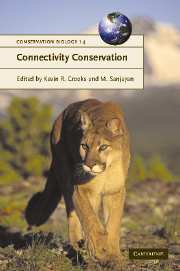Book contents
- Frontmatter
- Contents
- List of contributors
- Acknowledgements
- 1 Connectivity conservation: maintaining connections for nature
- PART I Approaches to connectivity research
- Introduction: Connectivity research—what are the issues?
- 2 Landscape connectivity: a return to the basics
- 3 Connectivity and metapopulation dynamics in highly fragmented landscapes
- 4 Genetics and landscape connectivity
- 5 Connectivity at the land–water interface
- 6 Influence of natural landscape fragmentation and resource availability on distribution and connectivity of gray wolves (Canis lupus) in the archipelago of coastal British Columbia, Canada
- 7 Migratory connectivity
- 8 Connectivity in marine ecosystems: the importance of larval and spore dispersal
- 9 Connectivity and wide-ranging species in the ocean
- 10 Hydrologic connectivity: a neglected dimension of conservation biology
- 11 Connectivity and ecosystem services: crop pollination in agricultural landscapes
- PART II Assessing connectivity
- PART III Challenges and implementation of connectivity conservation
- Index
- References
5 - Connectivity at the land–water interface
Published online by Cambridge University Press: 24 May 2010
- Frontmatter
- Contents
- List of contributors
- Acknowledgements
- 1 Connectivity conservation: maintaining connections for nature
- PART I Approaches to connectivity research
- Introduction: Connectivity research—what are the issues?
- 2 Landscape connectivity: a return to the basics
- 3 Connectivity and metapopulation dynamics in highly fragmented landscapes
- 4 Genetics and landscape connectivity
- 5 Connectivity at the land–water interface
- 6 Influence of natural landscape fragmentation and resource availability on distribution and connectivity of gray wolves (Canis lupus) in the archipelago of coastal British Columbia, Canada
- 7 Migratory connectivity
- 8 Connectivity in marine ecosystems: the importance of larval and spore dispersal
- 9 Connectivity and wide-ranging species in the ocean
- 10 Hydrologic connectivity: a neglected dimension of conservation biology
- 11 Connectivity and ecosystem services: crop pollination in agricultural landscapes
- PART II Assessing connectivity
- PART III Challenges and implementation of connectivity conservation
- Index
- References
Summary
INTRODUCTION
There is a growing appreciation in ecology and conservation that even those habitats and ecosystems (we will use these terms interchangeably) traditionally considered “insular” are in fact reticulately connected (Polis and Strong 1996). These connections are mediated by both physical and biological processes spanning a wide range of spatial and temporal scales (Polis and Strong 1996). This is clearly true of linkages between similar habitat types, such as fragmented systems, or patchily distributed communities (e.g., see Moilanen and Hanski Chapter 3; DiBacco et al. Chapter 8). However, linkages are also critically important between very distinct habitats, such as forests and grasslands, freshwater and marine habitats, or aquatic and terrestrial ecosystems. In fact, as we will discuss in this chapter, if connected habitats are dissimilar we believe there is at least as much potential for movement of materials to influence the connected systems as when habitats are similar.
Inter-habitat connectivity has been formally recognized at least since 1923 (Summerhayes and Elton 1923), but recognition of the importance of linking systems for altering their productivity goes back much further (e.g., to ancient irrigation schemes, such as those in the Nile Delta of Egypt). Recently, an integration of the landscape and ecosystem ecology concepts of connectivity, and their potential to structure ecosystems, has begun to be examined in detail (e.g., Polis and Hurd 1996).
- Type
- Chapter
- Information
- Connectivity Conservation , pp. 97 - 129Publisher: Cambridge University PressPrint publication year: 2006
References
- 14
- Cited by



